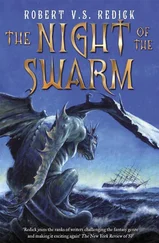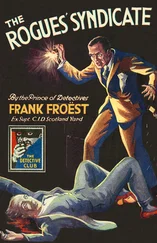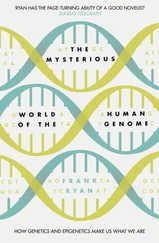'How can you tell it's dead?' asked Peak.
'Easy. Its metabolism stops. Besides, you can recognise a dead yrr because it stops glowing. For yrr, luminescing is a biochemical necessity. The best-known example of marine bioluminescence is probably the Aequorea , a hydromedusa from the South Seas. It glows when it produces a pheromone. A similar process is going on here. Pheromones are released by the yrr, causing them to glow. The flashes of light are a sign of particularly intense biochemical activity within the aggregated cells. When yrr luminesce, they're communicating and thinking. When they die, the light goes out.'
Oliviera looked at the others. 'So here's why we need to be afraid. The yrr use basic means to run a complex system of selection. If a yrr-amoeba is healthy and has a fully functioning pair of receptors, the pheromone triggers aggregation. But if that amoeba lacks a special receptor, the pheromone takes its deadly toll. The point is, a species that works like this has a very different perspective on death. Death in yrr society is vital. It would never occur to the yrr to spare a defective yrr-cell. To them it would seem absurd – stupid, even. It's imperative for them to destroy the threat to their own evolution. Whenever the collective is threatened, the yrr respond with the logic of death. It's no good pleading for mercy or expecting compassion. The logic of death doesn't make exceptions, and it's not about brutality. Such thoughts are alien to the yrr and, as such, they'll never understand why they should spare us – given that we're a concrete threat.'
'Uh-huh. So their biochemistry imposes a different morality,' said Li.
'Well, I dare say that's very interesting,' interrupted Vanderbilt, 'but what does it matter if they all use Chanel No. 5 or whatever? I mean, what's the point of knowing that? We could all go and aggregate with them. Yeah, that's it, I'll club together with some yrr.'
Crowe gave him a withering look. 'Like they'd let you.'
'Oh, screw you, Crowe.'
'You guys can keep fighting if you like,' said Anawak, 'but Karen and I have an idea about how yrr cognition might work. We've got Sigur, Mick and Sue pulling their hair out over it. Biologically, it's nonsense – but it would answer a whole heap of questions.'
Weaver took over. 'We programmed our virtual amoebas with electronic DNA, and set it up to keep mutating. In other words, the DNA was learning. All of a sudden we found ourselves back where we'd started – with a functioning neural network computer. We'd originally split our electronic brain into its smallest programmable units and tried to put them back together again as a thinking whole. It didn't work, or at least not until the individual cells were capable of learning. But the only way that a biological cell could learn is through mutations in its DNA, and that's unheard of- but it's exactly what we told our virtual cells to do. We used a scent, like Sue described.'
'The thing is,' Anawak continued, 'we didn't just get our fully functioning neural network computer back: we had yrr operating within their natural habitat. Our version of the network came with a few added extras – we allowed the cells to move through three-dimensional space. It replicated deep-sea conditions, with pressure, currents, friction and so on. First, we had to answer the question as to how members of a collective are able to recognise each other. The pheromone is only half of the story. The rest involves limiting the size of the collective. And that's where Sue and Sigur's discovery comes into play. They found that yrr amplicons differ from each other in small, hypervariable sections, so, as we said before, the cells would have to change their DNA after they came into being. Well, we think that's exactly what happens, and that these hypervariable sections serve as a code for them to recognise each other and to know which collective they belong to.'
'Yrr-amoebas with the same coding recognise each other, and small collectives can aggregate with larger ones,' said Li.
'That's right.' Weaver nodded. 'So we coded our virtual cells too. Each cell already had basic information about its habitat, but some cells were given additional information that the others didn't have. As you'd expect, the first cells to aggregate were the ones that shared the same coding. Then we tried a different tack, and attempted to join two collectives with non-identical coding. It worked, and the unthinkable happened: the cells not only succeeded in aggregating; they managed to exchange their individual coding and mutually update each other. They programmed themselves to share the same standard code, thereby attaining a new state of knowledge. The two collectives merged into one, which joined with a third, and that, too, gave rise to something new.'
'Next we wanted to examine their learning strategies,' said Anawak. 'Once again we created two collectives, each with different coding. We gave one information about a specific experience – an enemy attack. It's not especially original, I know, but we decided to use a shark. We programmed it to take a big bite out of the collective, then we showed the collective how to dodge it. The second collective wasn't taught the trick, and it got bitten. Then we aggregated the collectives and sent in the shark – the new conglomerate dodged it. The whole mass of cells had learned what to do. Finally, we divided the collective into smaller groups, and all of them knew how to dodge a shark.'
'So the hypervariable sections allow them to learn?' asked Crowe.
'Yes and no,' said Weaver, glancing at her notes. 'It's theoretically possible, but on the computer it takes too long. The mass of jelly that attacked us on the well deck was incredibly quick to respond, and it probably thinks just as swiftly. It's a superconductive organism, an enormous variable brain. It didn't make sense to limit ourselves to small segments of DNA. We programmed the entire strand so it was capable of learning, and that increased the speed of cognition enormously.'
'Leading to what?' asked Li.
'We can only base our conclusions on the few trials that we ran before the meeting, but we've already seen enough to be sure of a few things: yrr-collectives, no matter what their size, think at the speed of the most up-to-date parallel processors. The information held by individual cells is standardised, and new data gets scrutinised. We found some of the collectives weren't able to handle new challenges, but as they aggregated, they learned. Initially, the learning curve was linear, but beyond a certain point, the collective's behaviour couldn't be predicted-'
'Hold on.' Shankar interrupted her. 'Do you mean to say that the program takes on a life of its own?'
'We introduced entirely new situations. The more complex the problem, the more frequently the amoebas aggregated. It didn't take them long to develop strategies that hadn't been programmed. They started to work creatively. They became inquisitive. And they learned exponentially. We only had time to do a few tests, and it's only a computer program, but our electronic yrr learned to assume any given form – to imitate and vary the shapes of other living things. They were able to form feelers that made our fingers seem no more sensitive than cudgels. They examined objects on a nano level. And every single one of their experiences was shared with every single cell . They solved problems that would leave us stumped.'
For a moment there was silence as the news sank in. It was clear from their faces that they were remembering the scenes on the well deck. In the end Li said, 'Give me an example of a problem.'
Anawak nodded. 'Let's say I'm a yrr-collective. I've managed to infest an entire continental slope with worms that I'd previously bred, packed with bacteria and transported across the seabed. I want them to destroy the hydrates along the length of the slope, but there's one small problem: although the worms and the bacteria are causing a hell of a lot of damage, they can't start the landslide without help.'
Читать дальше












